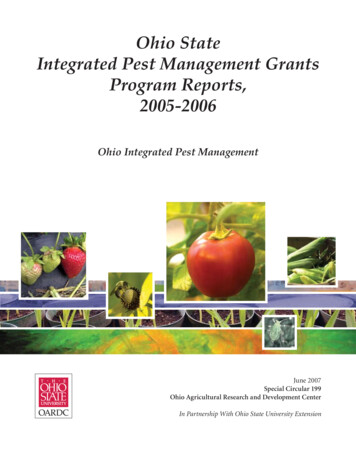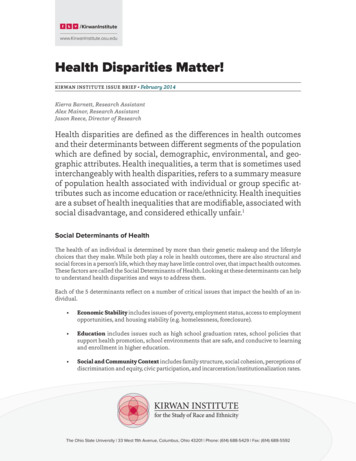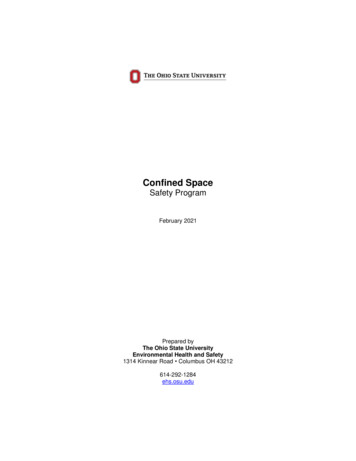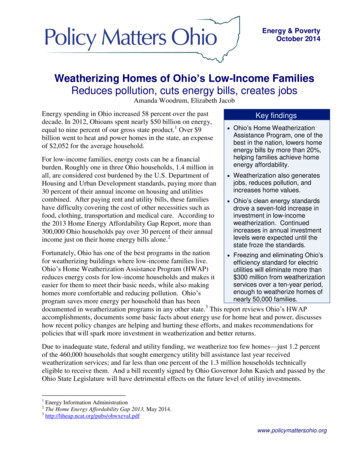
Transcription
Facilities Operations and DevelopmentEnvironmental Health and Safety1314 Kinnear Road #106Columbus, OH 43212-1168614-292-1284 Phone614-292-6404 Faxwww.ehs.osu.eduWorking Alone Safety ProgramPrepared by:The Ohio State UniversityEnvironmental Health and SafetyOccupational Safety & Industrial Hygiene1314 Kinnear RoadColumbus, OH 43212-1168614-292-1284 Phone614-292-6404 Faxwww.ehs.osu.eduRevised 2016
Page 2Table of Contents1.0 Introduction32.0 Responsibilities33.0 Risk assessments44.0 Who shouldn’t work alone55.0 Training5Appendix A: Checklist for working alone7
Page 31.0 Introduction1.1 Some job functions at The Ohio State University will be performed by lone workers. This program is toencourage awareness and promote safe work procedures for employees who work alone. Workingalone describes situations during the course of employment when an employee is The only worker at the workplaceNot directly supervised by the employerWorking at a site where assistance is not readily availableIn an area where direct contact with a co-worker or supervisor is not availableIn a dangerous area (either due to work processes or likelihood of being robbed)Traveling away from the base office to meet clients1.2 The objectives of the Working Alone Program are: Identify hazards to workers working alone and to try to eliminate, minimize or control themProvide assistance for workers working alone in the event of an accident or emergencyIdentify responsibilities of employees and supervisorsRecognize who should not work aloneProvide training assistance1.3 The Working Alone Program applies to OSU employees whose job duties require them to work alonein any facets of the job.2.0 Responsibilities2.1 Environmental Health & Safety maintains, reviews, and updates the Working Alone Safety Programand provides assistance and recommendations at the request of supervisors.2.2 Employees Working Alone are responsible for:2.2.1Recognizing the hazards associated with their jobs and how to minimize them.2.2.2Reporting hazards to supervisors.2.2.3Working alone only when necessary, rescheduling assignments (when possible) to keep fromworking alone.2.2.4Participate in a check-in system by contacting someone at regular intervals.2.2.5Carry a personal alarm, cell phone or two-way radio. Ensure sufficient operation and batterylife.2.3 Supervisors/Departments are responsible for:2.3.1Communicating these guidelines to employees, students and contractors through trainingprograms.2.3.2Ensuring work performed alone or in isolation has a completed risk assessment that has beenshared with the lone worker.2.3.3Adequate control measures are implemented prior to approval of work.2.3.4Consulting and training staff, students and visitors that work alone.2.3.5Provide communication devices such as cell phones, radios, personal safety alarms.2.3.6Ensure employee health and safety.
Page 42.3.7Ensure lone workers understand the risks associated with their work and that the necessarysafety precautions are carried out.2.3.8Provide guidance in situations of uncertainty.2.3.9Implement controls to eliminate or control hazards prior to lone work.2.3.10 Supervision of health and safety issues when checking the progress and quality of work;periodic site visits and discussions in which health and safety issues are raised.2.3.11 Provide video surveillance cameras, limit public access, lock all unused doors, coded cards orkeys to control access to buildings, alarms, panic buttons, emergency phones, fire alarm orsecurity guards when necessary.3.0 Risk Assessment3.1 Before allowing a worker to work alone, the attached assessment should be completed and thefindings recorded. The assessment includes:3.1.1Identification of hazards within the area.3.1.2Identification of methods and frequency of communications.3.1.3Can any temporary access equipment, such as portable ladders or trestles, be safely handledby one person?3.1.4Can all the machinery and goods involved in the workplace be safely handled by one person?3.1.5Are there any chemicals or hazardous substances being used that may pose a risk to theworker?3.1.6Does the work involve lifting objects too large for one person?3.1.7Is more than one person needed to operate essential controls for the safe running ofequipment or workplace transport?3.1.8Possibility of violence.3.1.9History of client/customer – is it safe to visit alone?3.1.10 Medical fitness of the person working alone – possibility of illness.3.1.11 Possibility of accidents – consider the activities taking place e.g. accessing ladders or steps3.1.12 If the lone worker’s first language is not English, are provisions made for clearcommunications, especially in case of emergency?3.1.13 Requirements for first aid training.3.1.14 How can supervision/advice be provided easily?3.1.15 Methods of raising the alarm in the event of no contact within an agreed time.3.1.16 Can a person be left alone at their place of work?3.2 The risk assessment should help decide the right level of supervision.3.3 Identify the hazards of the work, assess the risks involved, and put measures in place to avoid orcontrol the risks.3.4 It is important to talk to employees and their safety representatives as they are a valuable source ofinformation and advice. This will help to ensure that all relevant hazards have been identified andappropriate controls chosen.
Page 54.0 Who shouldn’t work alone?4.1 Some job functions have inherent hazards that will require more than one employee at the job site.4.2 Some examples of work functions that present hazards that require more than one worker include:4.2.1Permit-required Confined Spaces4.2.2High energy materials (radioactive, high temperature)4.2.3Cryogenic (low temperature) materials/processes4.2.4Toxic gases, liquids or solids4.2.5Flammable liquids4.2.6High pressure or high voltage systems4.2.7Using fall arrest equipment and scaffolding4.2.8Equipment or machinery4.2.9Extreme weather conditions4.2.10 Shop Machinery4.2.11 Restraining or handling animals capable of causing injury4.2.12 Services where cash or goods are handled that may attract criminals4.2.13 Certain laboratory work5.0 Training:5.1 Training is particularly important where there is limited supervision to control, guide and help insituations of uncertainty. Training may be critical to avoid panic reactions in unusual situations. Loneworkers need to be sufficiently experienced and /or trained to understand the risks and how to fullytake precautions.5.2 Set limits for the worker as to what can and cannot be done while working alone.5.3 Ensure employees are competent to deal with circumstances which are new, unusual or beyond thescope of training, such as when to stop work and seek advice from a supervisor.5.4 Those individuals working alone must have the appropriate training for the identified hazards, trainingcan include providing workers with a safety checklist to assist them to identify and anticipate their ownhazards.5.5 Individuals who perform hazardous work will be provided written safe work procedures by thesupervisor.5.6 All equipment must be used as intended, according to the manufacturer's specification and as set outin the safe work procedure. All equipment must be maintained in good working order.5.7 Appropriate first aid and emergency supplies will be provided by the employer. The employee mustknow where first aid and emergency supplies are stored and how to use them properly. Employeesshall also be trained in methods of notifying the university or a supervisor when the needs arise.5.8 Individuals who may be at risk of violence because they work alone may need training in the use ofdifferent communication equipment and/or how to behave when confronted with a situation such as anintruder. The employee will work with the supervisor to identify the potential situation, options for itsresolution and the supervisor will arrange for appropriate training, as required.
Page 65.9 Those individuals working alone and with cash will receive special training in violence preventionprocedures for robbery.
Page 7Appendix A: Working Alone ChecklistWorking Alone ChecklistEmployee Name:Date:Contact Details:Contact Phone Number(s):Emergency Phone Numbers:Department:Supervisor Name:Name and Contact Info. for Person checking on employee:Method to be used for checking on employee:Intervals the employee will be contacted:Location of Activity:Has a risk assessment (must be attached) been conducted for this task?YESNOIs the employee trained in working alone procedures?YESNOIs the employee aware of all risks associated with the task?YESNOHas a safety inspection been completed prior to operating any equipment?YESNOHave emergency plans been discussed?YESNOIs Personal Protective Equipment (PPE) and training on proper use available?YESNOHave Standard Operating Procedures (SOPs) been provided and discussed?YESNOHave additional controls been put in place during this task/activity?YESNOCommunication Arrangements:Action to be taken if contact is not made in accordance with above schedule:Declaration:I,am aware and agree to abide by all The Ohio StateUniversity and other applicable procedures when working outside normal business hours, and/orworking alone, and/or in isolation. I agree to abide by any additional requirements as listed in theattached risk assessment for this activity.Signature of Employee:Date:Signature of Supervisor:Duration of Approval:Date:FromTo
www.ehs.osu.edu Working Alone Safety Program Prepared by: The Ohio State University Environmental Health and Safety Occupational Safety & Industrial Hygiene 1314 Kinnear Road Columbus, OH 43212-1168 614-292-1284 Phone 614-292-6404 Fax www.ehs.osu.edu . Page 2










